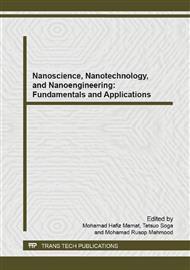p.281
p.286
p.291
p.295
p.300
p.304
p.309
p.314
p.319
Synergizing TiO2 Surface to Enhance Photocatalysis: A Green Technology for Clean and Safe Environment - A Review
Abstract:
Photocatalytic removal of pollutants from air and water is a green technology that helps us to maintain a healthy life, clean environment and a balanced ecosystem. Photo-excited TiO2 has strong oxidation ability that can be used to purify indoor air and polluted water. Numerous parameters such as UV light intensity, humidity, substrate concentration, substrate type and O2 partial pressure influence the removal rate of gaseous and/or aqueous contaminants. However, TiO2 photocatalyst cannot decompose large amount of contaminants or refractory chemicals because of the interference in light penetration by the bulk pollutants. Modification of TiO2 surface or combining the TiO2 photocatalyst with other advanced oxidation processes such as sonolysis, ozonization, electrochemical oxidation and photocatalysis could significantly improve the photocatalytic efficiency of TiO2 photocatalyst. This brief review is an up-to-date presentation of the TiO2 surface modification for enhancing its photocatalytic activities for environmental purification.
Info:
Periodical:
Pages:
300-303
Citation:
Online since:
June 2015
Authors:
Price:
Сopyright:
© 2015 Trans Tech Publications Ltd. All Rights Reserved
Share:
Citation:


